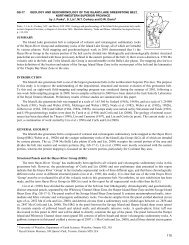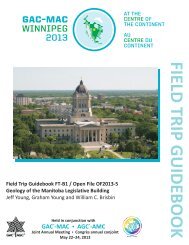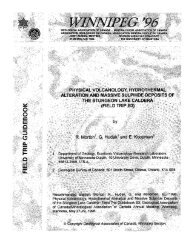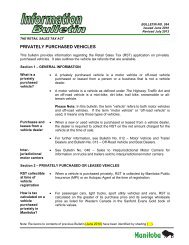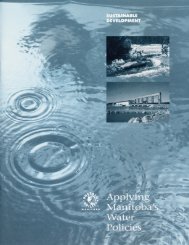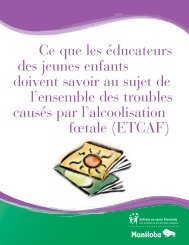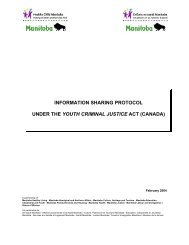Nutrient Management Strategy - Government of Manitoba
Nutrient Management Strategy - Government of Manitoba
Nutrient Management Strategy - Government of Manitoba
You also want an ePaper? Increase the reach of your titles
YUMPU automatically turns print PDFs into web optimized ePapers that Google loves.
Page 1IntroductionEutrophication is one <strong>of</strong> the most importantwater quality issues in the prairie and boreal plainecozones in western Canada. Water qualitymonitoring results indicate that most <strong>of</strong> the largeriver systems that flow across the prairie andboreal plain ecozones contain relatively highconcentrations <strong>of</strong> phosphorus and nitrogen, thetwo nutrients most commonly associated witheutrophication. The main factors that maycontribute to the high nutrient content in thesesystems include erosion <strong>of</strong> naturally fertile soils,surface run-<strong>of</strong>f <strong>of</strong> fertilizers from cultivated fields,run-<strong>of</strong>f from livestock pasture and feedlots, urbanrun-<strong>of</strong>f and storm sewer discharges, andagricultural, industrial, and urban sewage effluentdischarges. Some <strong>of</strong> the larger river systems thatare <strong>of</strong> particular concern to southern <strong>Manitoba</strong>include the Assiniboine, Souris, and Red Riversystems, all <strong>of</strong> which carry significant amounts <strong>of</strong>nutrients into the province from the west andsouth.Concerns have been raised over the potentialfor eutrophication processes to not only negativelyimpact rivers and streams that flow through theregion, but also adversely affect the water quality<strong>of</strong> Lake Winnipeg, since the lake is the eventualrecipient <strong>of</strong> the nutrient load transported by many<strong>of</strong> these rivers and streams.growth <strong>of</strong> opportunistic species, resulting in anoverall decrease in biological diversity across theentire ecosystem. As well, the decay process thatfollows the decline or die-<strong>of</strong>f <strong>of</strong> algal andmacrophyte populations uses up large amounts <strong>of</strong>dissolved oxygen. This can have seriousconsequences on aquatic animals, such as fish andinvertebrates, which rely on an adequate supply <strong>of</strong>dissolved oxygen for survival. Low oxygenconcentrations also result in the release <strong>of</strong> thenutrient phosphorus from the sediment, making itavailable for algal growth. Eutrophication mayalso decrease the suitability <strong>of</strong> a water supply fordomestic use (including human drinking),livestock watering, and recreational use. Algalblooms associated with eutrophic waters are <strong>of</strong>tendominated by species <strong>of</strong> blue-green algae, some <strong>of</strong>which are known producers <strong>of</strong> potent nerve andliver toxins. Such a situation can present a healthrisk for humans, household pets, and livestock thatdrink the water, and for people who use the waterfor recreational purposes. There is also someevidence that the toxins produced by blue-greensmay be transferred up the food web, and mayadversely affect wildlife populations such as fishand water birds. Besides being potentially toxic,the presence <strong>of</strong> an algal bloom in a drinking watersource can clog treatment plant filters, and <strong>of</strong>tenimparts an unsightly appearance, and unpleasanttaste and odour to the finished water. Algalblooms and extensive macrophyte growth are alsoconsidered aesthetically unappealing and candetract from the recreational use <strong>of</strong> a surfacewater.The water quality problems that arise as aresult <strong>of</strong> eutrophication <strong>of</strong> drinking andrecreational waters are difficult and expensive toremedy. For drinking water sources the cost <strong>of</strong>additional treatment may be prohibitive in manyjurisdictions, while for recreational waterbodies, adecline in the aesthetic quality <strong>of</strong> the water canadversely affect tourism, and lead to decreasedland and cottage values.<strong>Nutrient</strong> enrichment can directly or indirectlyimpact the water quality <strong>of</strong> surface waters. Anoverabundance <strong>of</strong> nutrients can lead to excessivegrowth <strong>of</strong> algae and macrophytes within anaquatic system, which can greatly alter the overallstructure <strong>of</strong> the ecosystem by favouring the<strong>Nutrient</strong> enrichment has long been recognizedas a major water quality issue. Many importantsteps have been implemented in <strong>Manitoba</strong> andelsewhere to better understand and to implementappropriate and feasible control options. Waterquality objectives were first developed forFor Additional Information, Visit <strong>Manitoba</strong> Conservation’s Website for Current Issues - Latest Newswww.gov.mb.ca/environ/



